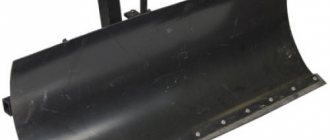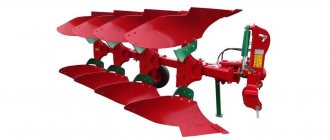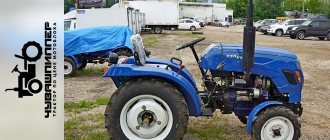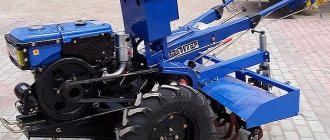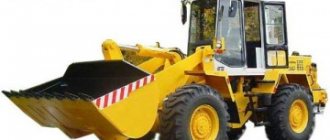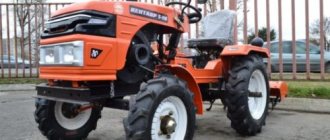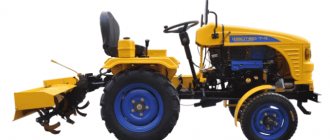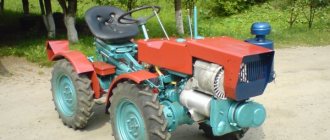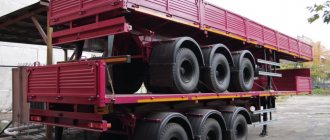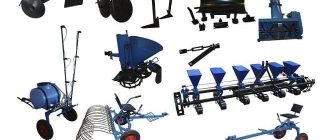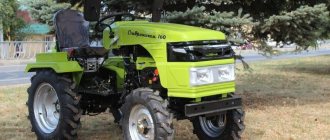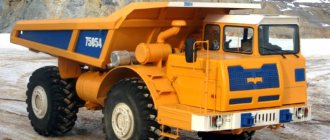Extractor
The extractor is designed for pulling out previously clogged or incorrectly clogged posts, as well as replacing them during local repairs of fences. The extractor is a mechanical gripper and a reverse lever system (yoke), with the help of which the post is removed from the coating by blowing the hammer and pushing it upward. The kit also includes a hydraulic outrigger cylinder to support the hammer mast in the ground/asphalt and hydraulic hoses for connection to the hydraulic distributor.
A video of the extractor in action is available here
up
Hydraulic percussion drill
Hydraulic pneumatic hammer drill for drilling concrete, rock, difficult soils, etc. The drill consists of a hydraulic motor, a pneumatic impact shaft and a drill head. This drill is mounted on the hammer mast and allows you to drill holes of various diameters where the machine cannot drive without drilling, for example when the road has a layer of concrete or hard rock in the form of boulders and large stones at the base. The exception is reinforced concrete, where it is necessary to use a core drill. Rotation and feeding are carried out from the machine’s hydraulic system, and shock movements from an air compressor with a capacity of 7-10 thousand l/min (the compressor is not included in the delivery package). The drill head has special holes through which drilling products are blown out with compressed air. The drill does not require frequent installation/removal, as it does not interfere with driving in the posts.
Characteristics of a standard drill with RP200 drive and RH5 shaft:
- Torque 160 Kgm.
- Required oil flow 30 l/min.
- Drill speed range from 30 to 400 rpm.
- The maximum drilling depth is standard up to 1500 mm.
The required drilling depth and diameter are discussed with the Buyer in advance.
Additionally, the drill can be equipped with a dust collector , which will accumulate drilling products. It does not allow dust to fly around the object, thereby not polluting it and allows you to work within the city, near residential buildings.
Video of a drill working on concrete https://www.youtube.com/watch?v=R6fgqJLW1zI
up
Areas of application of piling equipment
Construction with preliminary arrangement of a pile foundation is a fairly common method of constructing buildings and structures. This is especially true for northern latitudes, where you have to work mainly with frozen soils. During the operation of buildings, the upper layers of soil begin to warm up and gradually move. To exclude such a development of events, piles are used. They are a connecting element for distributing the load onto denser layers of soil located at depth.
In addition, driving piles is often necessary to strengthen unstable soils when constructing trenches and pits. Reinforced concrete or metal pillars prevent erosion and deformation of the soil, which can subsequently cause uneven settlement of the object and cracks on the walls.
Pile driving machines are used:
- in housing construction;
- during the construction of industrial facilities;
- when laying pipelines and technological lines;
- during the construction of power lines, mobile communication masts;
- during the construction of berths and piers.
Piles have proven their effectiveness in implementing construction projects on soils with low strength, heaving and significant freezing depth (clay, sand, sandy loam, loam). The strength and reliability of a pile foundation does not depend on the groundwater level and terrain features. A machine with piling equipment can work in almost any conditions, the only exception being rocky soils.
Advantages of special pile driving equipment:
- the ability to use in areas with large elevation differences and drive piles to different depths;
- the machine can operate in any conditions without the need for preliminary preparatory measures;
- driving is performed at high speed, which increases productivity and reduces time costs.
How to choose a pile driver?
The piling machine is selected taking into account the complexity and volume of the upcoming work, soil characteristics and climatic conditions. If we are talking about large construction projects, then tracked or rail-mounted equipment is more suitable for these purposes. It is characterized by high power and the ability to provide significant impact load. It should be noted that a rail-mounted machine is considered the most difficult to install and requires additional equipment to be moved to the site. A tracked vehicle also cannot move independently on public roads, but it is capable of demonstrating high efficiency when operating in difficult conditions (for example, when driving is required in dense urban areas or on difficult terrain).
Units on a wheeled chassis are characterized by high mobility and good maneuverability. Such modifications are more suitable for performing small-scale work on dispersed objects, for example, during the construction of panel houses or in low-rise construction.
Hydraulic Screw Drill
A hydraulic screw drill is designed for drilling holes in the ground or a thin layer of asphalt for the installation of road signs, poles, etc. The drill is a hydraulic motor freely swinging in the transverse direction with an auger shaft with a standard diameter of 250 mm and a length of 1000 mm. (it is possible to change the diameter and length by order of the Buyer), which allows you to drill holes at an angle. At the peak of the auger there are 8 cutters (similar to cutters of road milling machines), which allow you to pass through small layers of asphalt or compacted soil. The drill is installed and removed in 1-2 minutes and does not require any tools. Required oil flow 60 l/min. Torque 1930 Nm.
up
Piles
Piles are wooden, metal, concrete or reinforced concrete rods, hollow or solid inside, immersed in the ground to create reliable support for a future building or other structure. Piles are loaded in a vertical or inclined position. Their functional purpose is to transfer pulling, pressing and shearing loads from the structure to the ground. In other words, piles strengthen weak soil layers and transfer the effective load to the underlying layers.
Most often, reinforced concrete piles with different cross-sectional shapes are used for construction. Inside this pillar there is a frame made in production conditions using a pile-coiling machine. The lower part of the post has a cone shape, which simplifies the process of immersion into the ground. The impact energy transmitted by the pile hammer falls on the top of the pile.
The force on the ground is transmitted through the side surface and through the bottom of the pile. Based on the type of load transfer, a distinction is made between supporting structures (the force on the ground is transmitted through the lower part), friction piles (the force is transmitted mainly by friction of the side surface) and anchors. Depending on the characteristics of the soil and the complexity of the structure being erected, pile supports can work either individually or in a group. In the second case, the piles are arranged in a cluster, at a small distance from each other, and form a so-called pile bush or pile field.
A separate classification has been developed for piles, based on various characteristics of structures. One of the main parameters is the method of immersing the piles into the soil. Piles can be drilled, bored, screwed, ground-melted, or driven. And if the deepening of bored or screw rods can be carried out without the involvement of large-sized special equipment, then when working with driven structures it is impossible to do without specialized installations. Driving is only possible if there is a pile driving machine at the construction site.
Machine classification
Depending on the drive mechanism used, pile driving machines are divided into three groups:
- mechanical hammers;
- impact hammers, diesel or hydraulic;
- vibration machines.
In mechanical machines, the hammer is lifted using a special cable to a height of up to 3 meters. Upon reaching the highest point, the hammer lowers down, plunging the pile into the ground. The cycle of operations is repeated until the support is immersed to the required depth.
Impact units are driven by compressed air for diesel hammers and by hydraulic oil for hydraulic hammers. There are simple and double cycle mechanisms. In the first, the force of compressed air is spent only on lifting the hammer, in the second – on lifting and striking the pile. The performance of drum machines is much higher than that of mechanical machines.
The design of vibration installations provides for imbalances. This allows vibration of the actuator to be created in parallel with the shock pulse. Piles buried in the soil can be removed if necessary. However, machines of this type are used only for soft soils.
According to the method of movement, pile driving machines are divided into three groups:
- wheel-mounted installations;
- tracked vehicles;
- rail-mounted pile driving machines.
Installations based on automobile platforms are characterized by high speed of movement and the ability to move long distances independently, without the use of additional equipment. Automobile cranes based on all-wheel drive tractors Ural-375, Ural-420, KamAZ-43226, Kraz-250 are characterized by good maneuverability, but are inferior to larger pile drivers in functionality. Thus, the maximum cross-section of piles with which they can work is 35 x 35 cm, while the weight does not exceed 4.5 tons. The BM 811 pile driver is based on the Ural vehicle. The installation is equipped with a hammer running on a diesel engine and is capable of driving piles up to 12 meters long and weighing from 1.2 to 3 tons into the ground.
EO-5111(16)(19), RDK, MKG, DEK, BM-833, SP-49D are used as a base for tracked vehicles. A crawler-mounted machine is the optimal solution for a construction site. It maneuvers well in confined spaces, has relatively small dimensions and high power. Tracked vehicles are capable of deploying almost on the spot, as well as driving piles up to 14 meters long and weighing up to 5 tons in a vertical and inclined position. But it has a significant drawback: the inability to move on public roads independently. Therefore, if transportation over long distances is necessary, you will have to use trawls or semi-trailers.
Rail-mounted pile driving machines are used in the construction of residential areas, large industrial buildings and other facilities where large volumes of pile driving are required. These installations are characterized by high power and productivity. Disadvantages - bulkiness, limited maneuverability, minimal mobility.
Depending on how the driving is done, there are:
- installations that drive piles without moving within the radius of their position;
- mechanisms that drive piles separately.
The machine for driving piles within the radius of its position is equipped with a rotating platform. Due to the rotation angle of 360 degrees, work is performed within a radius of 6-10 meters, which significantly speeds up the production process.
The machine, which works with each pile separately, does not have a turntable. As a rule, the pile driver does not move on a wheeled or tracked base, but along rail tracks laid within the construction site.
We offer a wide range of piling machines with different performance characteristics. When choosing, it is necessary to take into account productivity, load capacity, average immersion depth of the pile element, lifting speed to a given height, mast dimensions and inclination angle. In the list of characteristics of the mechanism, special attention should be paid to the dimensions of the pile, that is, its diameter and length. Thus, the standard section size for most pile-driving installations is 30 x 30 cm, 35 x 35 cm and 40 x 40 cm, although there are specialized pile drivers that work with supports with a cross-section of 45 x 45 cm. The permissible length of the driven pile depends on the parameters of the machine’s jib crane. Typically the length of the support does not exceed 16 meters. If these values are higher, composite structures are used.
The weight of common hammers ranges from 1 to 13 tons, the maximum drop height is 3 meters. The number of beats per minute directly depends on the height of the fall.
Operating principle of piling equipment
The pile driving machine operates on the principle of a continuous auger. The entire cycle includes two stages. This:
- preliminary well drilling;
- installation and driving of piles.
First, at a given point, a leader hole is drilled in the ground using a drill. Then the pile is dragged to the installation site. Considering that a standard pile is 12 meters long and weighs up to 4 tons, it is impossible to do without the use of special equipment. The work is carried out using pile drivers - wheeled or tracked installations equipped with a lifting mechanism (boom). The length of the boom must be sufficient to lift the piles into a vertical position. In addition, the pile driver is equipped with a powerful and heavy impact hammer made of high-strength cast iron, as well as a drive mechanism.
The pile is raised in accordance with the design - vertically or at an angle, after which it is installed in the leader well. Driving piles is carried out using a pile driver equipped with a hydraulic, diesel hammer or mechanical hammer. If this is a pile driver with a simple design, then its full operating cycle consists of two stages: raising the impact part to a given height and its falling onto the pile head. The mechanical hammer first rises along the mast guides to the top point, and then, after disengaging the winch grip, under the influence of its own weight it lowers onto the pile head. The holding clutch disengages when there is a strong tension in the control mechanism rope.
During the process of driving a pile using an impact mechanism, a so-called pile failure may occur. This is explained by the fact that the compacted soil reaches a degree of resistance equal in value to the impact force of the pile. In this case, work must be stopped and the pile must not be touched for several hours. During this time, the tension in the soil will subside, and it will be possible to begin driving again.
Hydraulic core drill
Hydraulic core drill for drilling with diamond bits and taking cores. Allows you to make holes in reinforced concrete, layers of asphalt concrete, rock, etc.
Drill characteristics:
- Drive power: 4.4 kW.
- Number of revolutions per minute: 1 - 1000.
- Used crowns, diameter: 50 – 500 mm.
- Gearbox for speed control.
- Crown connection: 1” ¼.
- Rake for controlling the depth and force of feed.
Video of the work is available at the link
up
What operations does a piling rig perform?
The technological process of driving piles includes a number of sequential operations that are carried out using a pile driving machine:
- moving the pile driver to the place of immersion of the next pile (several piles)
- its installation and location verification
- pulling up the pile
- its lifting and installation in the position corresponding to the project
- driving piles
- measurement of the pile immersion value
- its dynamic test
May be useful for you:
- Junttan pile driver rental
- Pile driving machine, more details
Automatic mast vertical control system
System for automatically controlling the verticality of the mast through an electronic leveling system. The electronic leveling system acts on a proportional distributor, which always keeps the hammer mast in a strictly vertical position and therefore makes it possible to drive all posts vertically without visual control of the spherical bubble level. The equipment allows you to increase labor productivity (the operator does not need to control the vertical for each stand) and reduce the likelihood of erroneous driving of the stand, since the machine automatically continuously monitors the position of the hammer mast.
For a video of the operation of a machine equipped with an automatic control system for the verticality of the mast, see the link
up
Technical characteristics of the machine
USA has the following parameters:
- The height of the pile driver is 14 meters.
- The maximum boom reach is 4.85 meters.
- Diesel hammer type UR-1250 or UR-1800
- The weight of the impact part of the hammer is 1250 or 1800 kilograms.
- The ability to drive piles within a radius of 6 meters without changing the location of the machine.
- The coverage angle of this special equipment is 220 degrees.
- Average productivity is approximately 15-20 piles per work shift.
- Chassis wheel formula 4x6
- Engine power 220 horsepower.
- The maximum length of driven piles is 12 meters
Laser leveling system
The system of laser leveling of the depth of driving posts allows you to install the fence with high accuracy in height, regardless of the unevenness of the roadway.
The operating principle of the system is as follows. On a section up to 300 m long, using a rotating laser on a tripod, a plane is set at a certain height from the control point and with a certain angle relative to the horizon. A laser beam receiver is rigidly mounted on the hammer of the machine, which controls the electrovalve of the hydraulic system and cuts off the operation of the hammer. During operation, when the hammer drops to the height where the beam and the receiver coincide, the automatic shutdown of the hammer will work and the stand will be driven strictly to a certain height. Thus, the upper edge of the clogged racks will be aligned strictly along the beam, without repeating the unevenness of the road surface.
The system includes a set of equipment with the following characteristics:
- laser level H3CS: red beam visible to the naked eye;
- beam rotation 600 rpm;
- beam power over 150 m.
- acoustic receiver model LS-70C;
- automatic self-leveling;
- enabling manual operation mode for inclined planes;
- electronic leveler with relative and absolute inclination angles selectable from the keyboard;
- powered by alkaline batteries, over 60 hours of battery life;
- accuracy 3.5 mm;
- water and dustproof housing;
- compatible with receiving systems for monitoring the movement of earthmoving machines;
- tripod with level adjustment using a rack;
- receiver for a laser level, installed to control on/off. solenoid valve LS-B4;
- receiver support rod;
- remote repeater.
For a video of the operation of a machine equipped with a laser leveling system, see the link
up
Universal pile driving unit USA Kraz-250k
The USA is a KRAZ-250k automobile chassis equipped with a jib crane and attachments for driving bored piles.
USA is a multifunctional installation that is capable of performing the entire range of piling work. The operating cycle of a universal piling unit consists of the following operations:
- Moving the bored pile to the installation site;
- Slinging and raising the pile;
- Placement at the immersion point according to the design markings;
- Installation of a cap on the pile shaft, which protects it from destruction during driving;
- Docking of the pile and the loader (diesel hammer);
- Dismantling the sling;
- Driving a pile, during which continuous monitoring of the verticality of its immersion is performed;
- Uncoupling the pile and the loader;
- Removing the headrest.
The productivity of the universal piling unit is quite high; it is capable of driving up to 20 piles during one work shift.
Rice. 3 : USA immerses piles in both hot and cold weather
The functionality of the USA pile driver depends on what attachments it is equipped with.
When equipped with a USA diesel hammer UR1-1250, it is capable of driving bored piles with a cross-section of 300*300 mm weighing up to 3 tons; when equipped with a diesel hammer UR1-1800, the USA can drive piles weighing up to 5 tons.
The maximum length of loaded piles is limited by the height of the jib crane; USA is capable of working with piles up to 12 meters long.
Pre-heating system "WEBASTO"
“WEBASTO” pre-heating system for the main components of the machine when working in winter conditions. The system consists of a liquid circuit to which a resistor for the motor and a control unit are connected.
FLUID CIRCUIT: This part of the system is used as a means of supplying heat to the main components of the machine through an antifreeze fluid. The movement of the liquid occurs as follows: the heating boiler sucks in the liquid, where it is heated and sent to a T-shaped connection, which divides the flow of liquid into two circuits. The first circuit sequentially heats two heat exchangers, which are located inside the machine’s oil tank, then the liquid is returned and discharged into the container. The second circuit sequentially heats the diesel engine using an immersion heater and a direct-flow heater, then the diesel fuel enters the filter, where it is filtered, then the liquid is returned and discharged into the container. The return of the liquid to the container occurs through another T-shaped connection, which combines the flow from the two circuits. The hot liquid then passes inside the heat exchanger located under the battery and returns to the heating boiler. From this point on, the circulation repeats. The WEBASTO heating boiler runs on diesel fuel, which is supplied from the vehicle’s fuel tank using a small pump.
HEATER CIRCUIT: When the battery is warm enough, a timer on the control unit allows current to be sent to the heater, which is connected to the crankcase to warm it up. This heater only operates for a short time because it is powerful and prolonged use may drain the battery.
Using a standard timer, you can pre-select the start of heating for a period of up to 7 days.
up
When is piling installation necessary?
Hammering machines are special equipment that is widely in demand in construction areas where the use of pile foundations is common or where reinforced concrete piles are used as free-standing supports. Among the main ones we highlight:
- Residential construction, where pile driving rigs are used to create foundations for multi-storey buildings and private houses;
- Industrial construction, for the construction of foundations for warehouses, hangars, industrial buildings, storage facilities for agricultural products;
- Road and railway sphere, in the construction of bridges;
- Hydraulic construction - construction of piers, berths, hydroelectric power stations;
- Engineering field of construction - installation of power lines, ground pipelines.
Fig: Arranging a foundation from reinforced concrete piles for a multi-storey building
In addition to driving reinforced concrete piles, pile drivers are used for driving sheet piles; for these purposes they are used:
- To strengthen the perimeter of trenches and pits with sheet pile fencing;
- Stabilization of landslide zones and moving soils;
- Installation of sheet piling walls to prevent erosion of coastlines and embankments;
- Creation of sealed containers from sheet piles in soil (collectors for industrial waste, fencing the perimeter of landfills) and water (for the construction of buildings in flooded areas);
- For installation of sheet piling walls of buildings located below the zero soil level (underground parking lots, basement floors).
Important : pile drivers are also capable of dismantling foundations made of reinforced concrete piles and sheet piling by removing submerged structures from the ground.
Fig : Installing a sheet piling wall using a crawler pile driver
Distance control system
The system for controlling the distance between the driven posts allows the operator to install posts with equal spacing between them and eliminates the need for preliminary marking. The system is a telescopic rod, which is rigidly attached to the machine body with one edge, and the other rolls freely on wheels. A photocell is installed on the adjustable part of the rack, which is configured to catch the rack. The operator drives two posts with the required distance between them, records this distance on the rail and when the machine moves further, when the photocell reaches the next post, a lamp on the machine lights up indicating that the required distance has been passed and the next post needs to be driven in.
up
System for monitoring driving points using GPS coordinates
The system for monitoring driving points using GPS coordinates allows you to work with precise positioning devices in the GPS network. The coordinates for driving in the posts are entered into the machine’s memory according to the preliminary design. When using this system, there is no need to pre-mark the points for driving in the posts. This equipment works especially effectively when constructing fields of solar panels or fences on new roads created using special design programs, where all construction objects have precise GPS coordinates. The system allows you to minimize possible operator errors and when using it, the machine independently positions the hammer at the desired point with a perfectly vertical position of the mast.
For a video of a machine equipped with a GPS system, see the link.
up
Sale of piling equipment
Do you need a pile driving machine? Trade Master LLC specializes in the supply and sale of construction equipment and piling equipment. We always have in stock a large selection of diesel pile driving hammers, spare parts for hydraulic, tubular and rod hammers, pile driver masts and pile caps. The list of services includes servicing of domestic and imported pile drivers. We work directly with manufacturers, which eliminates the participation of intermediaries and additional costs.
Equipment purchased from us is provided with a full factory warranty. We strictly comply with all our obligations and deliver spare parts and components in a timely manner. Experienced specialists will advise you on the selection of machinery and equipment.
In addition, we carry out piling work:
- drilling of leader wells;
- driving, pressing and vibrating piles;
- installation of sheet piling and reinforced concrete grillages;
- dynamic and static tests.
To order a service, just fill out an application on the website. Our managers will contact you and answer all questions.
Roller system for raising fence beams
The roller system for raising fence beams is designed to work with pre-laid and bolted fence beams. Allows you to simplify manual labor when installing the fence, and also makes it unnecessary to pre-mark the places where the posts will be driven in. Since the beams are laid out and bolted together, the machine operator sees the place where the post should be driven, opposite the holes in the beams. The design of the system allows you to adjust the distance of the beam feed from the edge of the machine chassis (reach) and adjust the height from the coating.
up
Our piling rigs
Our company uses wheeled and tracked piling machines based on URAL, KrAZ vehicles and excavators. They are equipped with modern powerful diesel hammers and have a rotating platform, which allows you to drive up to 16 piles without changing the location. The savings in time and resources are quite significant, which allows us to keep prices for our services quite affordable.
Fig .: Driving piles with a crawler-mounted pile driver
To carry out work on the construction of foundations from reinforced concrete piles and sheet piling, our company uses the following types of pile driving machines:
- Junttan PM-20 pile driver, equipped with a Junttan HHK-5A hydraulic hammer (impact hammer weight 5 tons);
- Pile driver SP-49 with diesel rod hammer SP-5A (driver weight 1.8 tons);
- Universal pile-driving unit "USA" with a tubular diesel hammer UR-1800 (driver weight 1.8 tons);
- Drilling and piling machine BM-811, equipped with a continuous auger-type drilling string (length 8 m) and a tubular diesel hammer SP-75A (driver weight - 1.25 tons).
Each of the above models of special equipment is the best piling rig in its class. The functionality of these machines, as well as the scope of application, are different - we use BM-811 when it is necessary to drive piles using the leader drilling method, SP-49 and USA - when installing medium-sized pile fields (for low-rise and detached houses), Junttan PM-20 - for the implementation of large-scale projects.
Fig : Junttan PM-20 Crawler Piling Machine
Hydraulic multi-perforator
The hydraulic multi-perforator is a universal option for various types of drilling in both vertical and horizontal planes. The working part of the equipment can be equipped with several drilling heads (1, 2, 3, 4, etc.), with the help of which several holes can be made at once. Using appropriate drills you can drill metal, concrete, asphalt, etc. The option is especially effective when installing fence posts on anchor bolts when installing them on overpasses, bridges, overpasses, etc.
up
Cost of pile driving machines
We invite you to familiarize yourself with the range of piling installations and equipment presented in our catalogue. Here you will find everything you need to complete your construction projects. The cost of special equipment can be clarified with managers and offers the most favorable terms of cooperation. By participating in the Trade-In program, you can get a substantial discount and save a lot. Just hand over your old equipment to us and place an order for the purchase of new piling equipment.
A piling rig can be purchased on a long-term lease with subsequent purchase (leasing) or in installments. The first option is relevant when it comes to expensive special equipment. Installment plans allow you to pay for equipment in stages, over four months.
